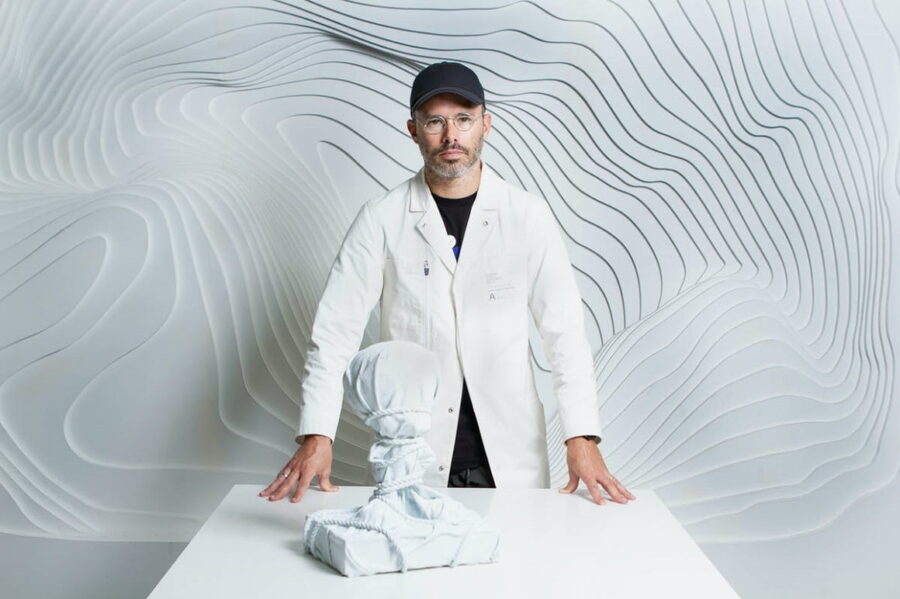Daniel Arsham offers a striking counterpoint in a time that seems defined by relentless churn and newness for its own sake: sculptures that feel both fossilized and fantastical. Known for his “fictional archaeology,” Arsham turns everyday objects, phones, cars, classical busts, into crystalline relics, prompting us to pause and consider not only what we leave behind but how we will be remembered. His current exhibition, Memory Architecture in Seoul, gathers these paradoxical forms into landscapes that appear rediscovered by future archaeologists, casting a contemplative light on the ephemerality of the now. Through sculpture, design, and installation, Arsham positions his work at the intersection of antiquity and innovation, inviting us to inhabit the space-time in between.

The Roots of Arsham’s Practice
Daniel Arsham was born in Cleveland in 1980 and trained at The Cooper Union in New York, an early foundation that would shape his emergent aesthetic. In 2007, he co-founded Snarkitecture with Alex Mustonen, channeling a sculptor’s vision into architecture, performance, and design, creating works that “reuse or misuse existing architecture to make it perform the unexpected.”
Soon after, his first gallery connection arrived via Galerie Perrotin in Paris, which came into his orbit through The House exhibition in 2004. Though his early ventures included stage and set design for Merce Cunningham, an experience pivotal for Arsham, his signature visual language emerged through his “fictional archaeology”: eroded casts of quotidian objects rendered in geological materials like volcanic ash, selenite, and quartz. These uncanny forms quickly gained traction across museum and biennale exhibitions, from PS1 to the Athens Biennale, framing Arsham’s project within a broader artistic excavation of time, memory, and obsolescence.
In 2014, Arsham launched Films of the Future, a production studio synthesizing his cinematic and sculptural work, most notably, Future Relic, a short-film series that imagines a civilization after Earth’s ecological unraveling. From these multi-disciplinary roots, Arsham has emerged as a contemporary artist who folds sculpture, design, film, and performance into a singular, immersive practice.

Navigating Today’s Arsham Terrain
Arsham’s presence across global art and design spheres continues to intensify. His exhibition Memory Architecture debuted at Perrotin Seoul in July 2025, following a major solo presentation at Lotte Museum of Art in 2024. Noteworthy within this body of work is Amalgamated Venus of Arles (2023), produced during a residency at the Louvre. Arsham reinterprets a classical plaster cast representing Aphrodite, that museum education relic, with a composite of high-polish steel, patinated bronze, and warm bronze, crafting a perceptual puzzle that compels viewers into a kind of sculptural labyrinth. The accompanying drawings and paintings extend this inquiry, inviting us into romantic, Caspar David Friedrich–like landscapes where colossal heads appear to emerge from ruins, bridging historical Romanticism and pop-cinematic adventure.
In March 2024, Fotografiska New York mounted Phases, the first exhibition dedicated to Arsham’s photography. Featuring black-and-white images that track the interplay of urban and natural spaces, Phases illuminates a lesser-seen facet of his creative ecosystem, photographs serving as catalysts for sculptural ideas.
Arsham’s collaborations span the cultural spectrum. As ComplexCon’s Global Artistic Director in 2025, he designed immersive installations for the Hong Kong (March) and Las Vegas (October) events. In Hong Kong, Arsham has repurposed the city’s disappearing neon imagery into a fractured, eroded entrance façade, a “broken, eroded hotel” echoing Las Vegas vibes, a move that situates his sculptural sensibility within pop-cultural critique and mass experience.
His design vocabulary extends into everyday objects. A standout is his partnership with Kohler’s Landshapes Collection shown at KBIS 2025, where mirrors, basins, pendants, and cabinet pulls carry his organic erosion motifs, fusing sculptural ideas with domestic functionality. He also published a monumental 688-page book in early 2025 focused on his motorsport-related sculptural art, detailing a process spanning concept to execution, including contexts such as the Orange County Museum and automotive events like Goodwood.
Even in the digital realm, Arsham remains active. While not covered exhaustively here, his partnerships with brands like Tiffany & Co. including 2023’s Tiffany-Pokémon encrusted eroded charms and ongoing projects with Dior, Rimowa, and Porsche amplify his reach into fashion, commercial artifacts, and collectible design.

Critical Perspectives
Yet amid applause, Arsham’s meteoric visibility triggers sharp critique. Some art critics warn that his “fictional archaeology” aesthetic risks aestheticizing decay into commodities. One reading in ArtReview laments: “Arsham morphs contemporary fear of oncoming end times into a gem-encrusted portrait of societal ruin, aestheticising disaster for profit.” Environmentally, Arsham’s use of recycled or cast-off materials, like beaching tiles or found plaster, as raw materials gestures to sustainable practice. But critics question whether these are substantive environmental commitments or merely symbolic maneuvers in an otherwise high-impact production model.
On a more conceptual level, Arsham has spoken about his creative origins, rooted in “accidents or failure,” and how drawing allows him to test ideas quickly, with sculptures following much later, a workflow that foregrounds experimentation over polished outcomes. In another interview, he reflects on Japanese aesthetics, omotenashi, or care in daily rituals, as a guiding principle in his approach to materials and presentation, a marker perhaps of an understated ethical dimension in his design philosophy. This interplay, between spectacle and sincerity, labor and craft, recession and novelty, forms the core of how Arsham is processed by contemporary observers.

Emerging Trends & Future Scenarios
Looking toward the next 5–10 years, several trajectories shape Arsham’s possible evolution. First, his role as ComplexCon’s Artistic Director suggests a growing influence in experiential and event-design arenas, his aesthetic might increasingly animate public spaces, commercial environments, and even urban branding.
Second, his multidisciplinary impulses, from film to photography, point toward narrative-driven, time-based installations. Future projects may blend moving image, sculpture, and live performance more fluidly. His Motorsports monograph hints at a willingness to canonize themed narratives and potentially repackage them in book, exhibition, or digital formats.
Third, his ongoing design collaborations, on domestic fixtures, fashion, and automotive objects, are likely to deepen. Yet if he redirects this toward institutional or civic-scale projects, e.g., site-specific public monuments or architectural commissions, it could align his work more firmly within design-as-civic engagement.
Fourth, labor equity and environmental integrity may emerge as necessary guardrails in his practice. If Arsham responds proactively to studio labor scrutiny and reinforces materials-based sustainability, rather than symbolic erosion, it may legitimize his ethical footprint alongside his aesthetic.
Finally, there’s a speculative cultural ripple effect: Arsham’s eroded-pop motif could shape broader design trends, seeping into digital interfaces, consumer electronics aesthetics, even experiential retail environments. In a moment when nostalgia, decay, and obsolescence are themselves cultural currencies, Arsham’s fictional archaeology may become a formal vocabulary across design disciplines.
Daniel Arsham’s multisensory practice, where sculpture, design, photography, and film converge, poses a rich proposition: that the future we build is also a ruin in waiting. His art prompts us to confront our material culture with both intimacy and distance, as though buried in geological strata. Alongside acclaim, he grapples with critique: about commodification, studio labor, and environmental integrity. Yet it’s precisely this friction that ensures his work remains compelling. As sculpture morphs into installation, and design into archive, Arsham challenges us to reconsider where, and when, history begins. His remains are not endings but openings, inviting us into a dialogue that is always unfolding, always in the present.









